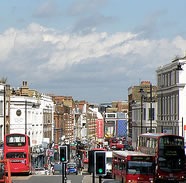'Startlingly high' levels of harmful emission exceed allowance in record time
Putney High Street has already seen a key pollution level exceed set limits more times already in 2015 than it is supposed to for the whole year.
The number of times Nitrogen dioxide (NO2) levels are supposed to exceed a certain value was breached during January in 2013 and 2014 but this year, for the first time, the limit has been breached within the first week of the year.

Putney High Street’s NO2 levels are already above the annual allowance of 18 ‘exceedences’, or events where the hourly level exceeds EU limits of 200 ug/m3.
Last year, the road was branded the worst in Europe for road pollution by a manager at Transport for London responsible for monitoring air quality. Wandsworth Council at that time said the main cause of pollution was buses, and has called on TFL to introduce ultra low emission vehicles.
Simon Birkett, Founder and Director of Clean Air in London, said: "Diesel exhaust is largely responsible for the startlingly high levels of nitrogen dioxide, a toxic gas, in Putney High Street. After some initial success, the Mayor and Council's interest in the problem has disappeared. Residents and businesses should demand big new measures as the Mayor seems to be using successfully in Marylebone Road."
London Assembly Member for Putney, Richard Tracey, told PutneySW15.com: "This is a repeat of the situation several years ago when, together with the Council members and officers, I called in TfL Buses for discussions on lowering the pollution levels emitted from their diesel powered buses. Of course Putney High Street is a particularly difficult place – a 'canyon' of high buildings through which too little air circulates properly to clear the potential pollution. TfL have now brought in a large number of hybrid and retrofitted cleaner diesel buses as they promised. The next stage will have to be diverting lorries and other polluting vehicles away from the High Street, not an easy task for Council planners.”
Deputy Chairman of the Putney Society, Jonathan Callaway said: “Within six days of the start of the year we have suffered 21 such events already according to the King’s College monitors (see http://www.londonair.org.uk/). The full year 2014 total was 999. Believe it or not this represents quite an improvement over 2013’s total of 1,580 and 2012’s truly awful total of 2,740, no doubt helped by the closure of Putney Bridge for several weeks. The trend is nevertheless positive and that is largely due to the introduction of cleaner buses following a campaign initiated by the Putney Society and supported by Wandsworth Council."
He continued: "But the totals still tell us we have a long way to go. Clearly we need rapid improvements in emission levels from traffic of all sorts but most especially diesel vehicles. Only urgent and much more robust action at government or mayoral level can enforce the changes we need – our Council plans to introduce improved delivery lorry times to reduce congestion at peak times, but this alone will not be enough. The Putney Society continues to discuss further measures with the Council and recently wrote to seek confirmation that new property developments on the High Street will not be allowed to worsen the canyon effect which is a contributory cause of the problem.”
Local resident Tim Henderson, who drew members attention to the limit being approached commented on the forum: "Well at least Oxford Street now beats Putney as the worst location - so the bus improvements have done something. And when the bridge was closed, levels were much better !"
Local MP Justine Greening said: “It is really concerning to see a breach so soon into the new year and shows why we need low emission buses to make a real difference. Pollution levels are still too high though and I’ll continue to work with councillors and to press TfL to improve this situation for residents.”
Deputy Council leader Jonathan Cook said: "Nitrogen Dioxide levels are much lower than they were when we first installed this monitoring station but there is clearly still a very long way to go before the high street can meet the EU target. The very high traffic levels combined with the ‘canyoned’ nature of the street mean exhaust emissions build up and cannot easily escape.
“The council’s ground breaking air quality and traffic studies on Putney High Street have been praised by the experts at King’s College London and were absolutely key to securing major investment to reduce emissions from London buses. This has resulted in significant year-on-year pollution decreases and our unique evidence base gives us a very strong case to campaign for more ultra low and zero emission busses to be brought into service here.
“We are also working with businesses on the high street to improve their loading arrangements which can help to smooth traffic flow and bring emission down further.”
Air quality and traffic studies
Find out more about the council's wider programme of air quality initiatives at www.wandsworth.gov.uk/airquality |
January 9, 2015